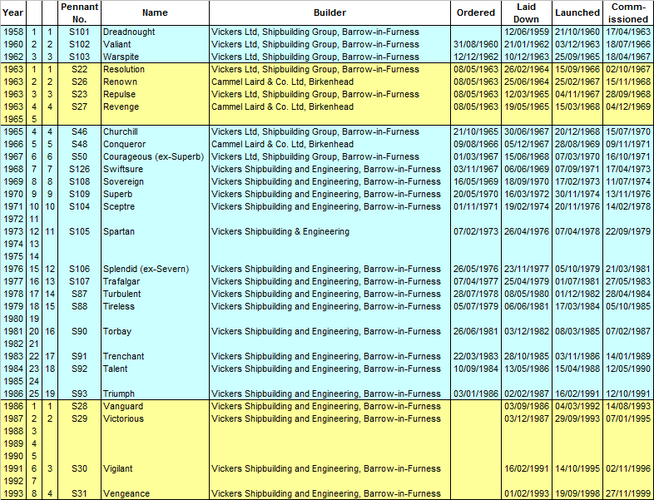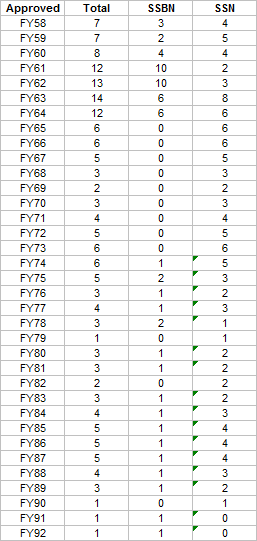Friedman's British Submarines In The Cold War Era provides some numbers for plans.
The 1962 LTC calculated a fleet of 20 SSN to ensure 8 at constant readiness in the Far East or alternatively 12 if 5 in the Far East could be reinforced by UK-based SSNs within a month. The target became 24 SSN to be built in 22 years.
The SSBN programme saw the fourth SSN deferred until after the first SSBN - the Admiralty assumed ordering 1 sub every 9 months until 1971 to make up the delay to cover SSN 05-12. The Treasury had wanted 1 per year...
It was thought that Cammell Laird becoming a second source would allow SSN orders every 6 months.
5 SSBNs would have allowed a continuous 1-submarine deployment to the Indian Ocean/Pacific to counter China using support facilities in theatre (Guam). With 4 subs there would be insufficient time on station to use Guam so additional facilities would have to be built. The on-station numbers have already been discussed above so I won't repeat those.
As to missiles, the USN had already advised the RN that Polaris A-3 would be replaced by the B-3 (which became Poseidon C-3). The government decided not to buy, and in 1967 the Labour Government said they would not buy it publicly. Within 6-8 years the UK dusted off the cancelled US-developed Antelope/ STAG decoy as Super Antelope then Super STAG which became Chevaline. The RN also looked again at Poseidon or a fifth SSBN. This was rejected in favour of the cheaper Chevaline option - which of course ballooned into anything but cheap.
Friedman also found evidence that the second Wilson government looked at a study converting the Resolutions to SSNs and ditching Polaris - what, if anything, was to replace the deterrent is unknown it seems.
The gap between Spartan and Splendid was due to the 1974-75 Review and capacity problems at Barrow.
By 1980 the order/completion interval was 15 months with an expected service life of 25 years. That would be sufficient for 16 SSNs and 4 SSBN. At this time improvements at Barrow saw Vickers offering 10/11-month intervals (at the expense of their surface ship construction) so 1 per year completing could raise the force to 21 SSN and 4 SSBN. The 1977 Fleet Requirements Committee wanted 24 SSN and 9 SSK. Of the SSN 5 would be north of GIUK Gap, 3 in the North Atlantic, 4 with the SSBNs and 7 with the RN surface task forces. 5 SSKs would be in the GIUK gap barrier and the other 4 supporting the SSBNs or doing shallow coastal work.
By 1983 direct support had been dropped but the desired numbers were now 27 active SSN and 13 active SSK with 7 SSN and 4 SSK in refit (total 34 SSN, 17 SSK). More SSNs were to be north of the GIUK gap (15) and 5 in it.
The 1985-90 Declared NATO Requirement was 20 SSN and 17 SSK. By 1985 the RN had 13 SSNs and estimated by 1991 it would have 18 but that would be the peak unless further construction was ordered. New SSKs would be needed too.
Torbay was ordered 11 months late due to financial issues (Nott - see below). As per the 1980 LTC:
SSN 15 (Tireless) - planned order April 1979, actual order July 1979
SSN 16 (Torbay) - planned order July 1980, actual June 1981
SSN 17 (Trenchant) - planned August 1981, actual March 1983
SSN 18 (Talent) - planned August 1982, actual September 1984
SSN 19 (Triumph) - planned August 1983, actual January 1986
At this time reopening Cammell Laird was not considered feasible given the level of investment required and lack of orders to keep it viable. Instead extending Valiant and Churchill and Swiftsure classes to 26 years and the Trafalgars to 30+ years was seen as more cost effective to cover the SSN build gap while the Vanguards were built.
SSN 20 was earmarked as the first of the SSN0Z design. SSN0Z was cancelled in autumn 1980 in favour of the SSBN class and it was clear that the SSN0Z design would not survive Nott anyway.
The 1981 LTC pushed the order for SSN 20 back to 1994. The Navy wanted a 1 per year order but this left Vickers with an 18-month gap. Decline in SSN numbers seemed inevitable during the mid-1990s (1 retirement per 18 months), falling from 19 in 1991 to 15 by 1999. The maximum building rate at Barrow was still 12-15 months. The Follow-On SSN (FOSSN) ideally had to be ordered in 1992. 5 FOSSN would serve until 2030. FOSSN was never ordered.
Work on the W Design studies began around 1985 and ended around 1989-90 but again nothing materialised (end of the Cold War). Batch 2 Trafalgar design work began in 1992. GEC got the contract as we know in 1996 before the shenanigans began and SSN 20 entered service as Astute in 2010 - some 25 years later than originally planned!!!!
When Trident came up the options were; an 80-cruise missile sub, Trident C-4, Trident D-5, or a modernised Polaris with new engines and Trident technology (A-4). In 1979 Repulse was thought to need replacing in 1991 due to a reactor vessel problem but the others could be refitted to serve well into the 1990s. The UK opted for C-4 in 1979 but in 1981 D-5 was on the scene which could not fit on a Polaris sub so that meant building a new class. In 1982 the UK opted for D-5 with some reduced R&D costs due to Reagan offering a deal but the rub was increased naval deployments outside of NATO in the Indian Ocean as a concession to the US for the deal. Friedman implies that the Nott cuts in 1981 were partly to pay for Trident. As part of this the US wanted the Friedman implies that the Nott cuts in 1981 were partly to pay for Trident. The US wanted the RN to retain Invincible instead of selling her to Australia (which Nott ignored) and to retain Intrepid and Fearless (which he did). The new SSBN fleet had a proviso that it might be a 3-sub fleet. Hopes to fit a (truncated) Ohio-class missile section were dashed as already a lot of the equipment was out of production. To ease the costs the initial deployment date was pushed back from December 1992 to December 1994. There was discussion of a fleet of 3x subs with 12x missiles each but no discussion of more than 4 submarines. Certainly the Trident SSBN programme pushed the SSN programme back too (see above).


